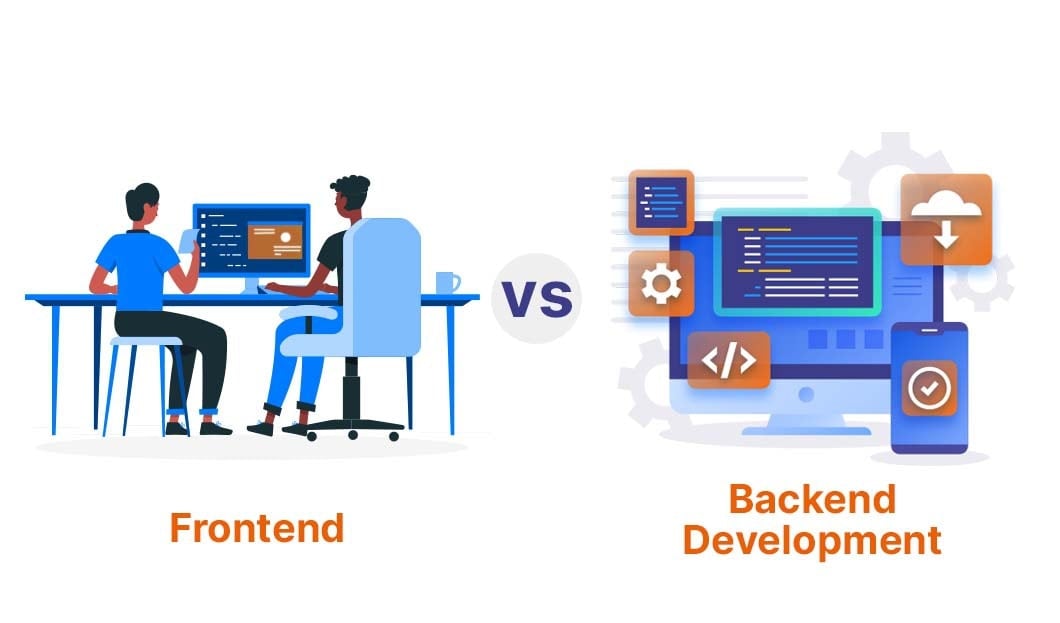Web development is a multifaceted discipline that involves different roles and responsibilities. Two critical components of web development are frontend and backend development. This blog will comprehensively compare frontend and backend development, exploring their definitions, technologies, focus areas, skill sets, and features.
By understanding the complete comparison between these two domains, you'll gain a clear perspective on their roles in creating successful web applications.
Let's Compare Frontend Development vs. Backend Development
1. Definition
What is Frontend?
We can define frontend development as creating the user-facing part of a website or application. It involves designing and coding elements that users interact with directly, such as the user interface (UI), visual layout, and overall user experience (UX).
What is Backend?
Whereas backend development focuses on building the server-side components of web applications. It involves writing code that handles data storage, implements business logic, communicates with external systems, and provides the necessary APIs for front-end interactions.
2. Technologies and Languages
Frontend: HTML, CSS, and JavaScript are the core technologies for frontend development.
Additional frameworks and libraries like React, Angular, or Vue.js are commonly used to build complex user interfaces.
Backend: Key technologies involved in backend development are programming languages like Python, Java, Ruby, or Node.js.
Backend Frameworks like Django, Ruby on Rails, Flask, or Express.js can be used to expedite development. Also, databases like MySQL, PostgreSQL, or MongoDB are used for data storage.
3. Features
Key Features of Frontend:
- User Interface: Frontend development revolves around designing and building visually appealing and intuitive user interfaces that enhance the overall user experience.
- Responsiveness: Frontend developers ensure that the application or website adapts and functions well across different screen sizes and devices, ensuring a consistent experience.
- User Experience: Frontend: Hire frontend developers and optimize the interaction between users and the application, ensuring it is intuitive, easy to navigate, and efficient in achieving user goals.
- Design Integration: Frontend developers collaborate with UX/UI designers to implement mock-ups, ensuring that the visual elements, color schemes, typography, and layout match the intended design.
- Client-side Interactions: Frontend development handles client-side interactions, such as form validation, data input, dynamic content updates, and client-side rendering, improving the interactivity and responsiveness of the application.
- Cross-browser Compatibility: You can hire frontend developers to ensure that the application or website functions consistently across different browsers, addressing compatibility issues and ensuring a seamless user experience.
Key Features of Backend:
- Server-side Logic: Backend development focuses on implementing the server-side logic that handles data processing, business rules, and algorithms required to fulfill user requests.
- Database Management: It handles data storage and retrieval using databases. They design and optimize database schemas, write queries, and ensure efficient data management.
- APIs and Integrations: Developers can design and implement APIs that allow communication between the frontend and backend components. They integrate with external services, third-party APIs, and other systems.
- Security: It also allows you to implement security measures, including data encryption, user authentication, access control, and protection against common vulnerabilities like SQL injection and cross-site scripting (XSS) attacks.
- Performance Optimization: With backend features, you can optimize server performance, database queries, and caching mechanisms to ensure efficient processing, reduce response times, and handle high traffic loads.
- Scalability and Load Balancing: Backend developers design and implement strategies to handle increased traffic and ensure the application can scale horizontally by distributing the load across multiple servers.
4. Focus Areas
Frontend:
Frontend development is dedicated to creating an attractive and engaging user interface. Developers in this field are responsible for designing and structuring the layout, ensuring responsiveness, and enhancing the overall user experience of websites and applications. They also handle client-side interactions to ensure a user-friendly and intuitive interface.
Backend:
Backend developers primarily focus on the server-side functionality and architecture of an application. Their responsibilities include managing data, implementing business logic, addressing security concerns, and integrating with external systems. Backend development enables seamless communication between the frontend and the server, allowing the frontend to retrieve the required data.
5. Collaboration Framework
Frontend:
Frontend developers closely collaborate with UX/UI designers to transform design mock-ups into functional interfaces. They also work with backend developers to define APIs and integrate front-end components with the backend infrastructure.
Backend:
Backend developers collaborate with frontend developers to establish data requirements, define APIs, and ensure seamless data communication. Growing companies should hire backend developers so that they may also work with database administrators, DevOps engineers, and system administrators to manage server infrastructure and maintain system performance.
| Frontend Developer | Backend Developer | |
| Technologies |
HTML, CSS, JavaScript, React, Angular, or Vue.js. |
Python, Java, Ruby, Node.js, Django, Ruby on Rails, Flask, or Express.js |
| Features |
User Interface, Responsiveness, User Experience (UX), Design Integration, Client-side Interactions, Cross-browser Compatibility |
Server-side Logic, Database Management, APIs and Integrations, Security, Performance Optimization, Scalability and Load Balancing |
| Focus |
visually appealing and interactive user interface |
Server-side functionality and architecture |
| Collaboration |
With UX/UI designers |
Frontend developers, database administrators, DevOps engineers, and system administrators |
What Kind of Jobs do Frontend Developers Have?
Frontend developers have a range of job opportunities in various industries and organizations. You should be aware of some typical job roles and positions for frontend developers.
- Frontend Developer/Engineer: These professionals are responsible for implementing a website's visual and interactive components or applications using HTML, CSS, and JavaScript.
- UI/UX Developer: They specialize in creating visually appealing, intuitive, and user-friendly user interfaces.
- Web Developer: With expertise in frontend development, web developers construct and maintain websites.
- Frontend Architect: These individuals offer technical leadership, establish best practices, guide the development team in technology choices, and optimize performance.
- Mobile App Developer: With the growing demand for mobile applications, frontend developers specializing in development focus on creating user interfaces for native or hybrid mobile apps.
- Frontend Team Lead/Manager: These professionals coordinate and prioritize tasks, offer technical guidance, and ensure successful project completion.
- Full Stack Developer: While frontend developers typically concentrate on the client side, some possess backend development skills, making them full stack developers. They are proficient in frontend and backend technologies, enabling them to handle full-stack development tasks.
What Kind of Job Do Back-End Developers Have?
- Back End Developer/Engineer: They are responsible for building and maintaining the server-side components of web applications.
- API Developer: API developers specialize in designing and developing application programming interfaces (APIs). They create APIs that enable communication between different systems or services, allowing data exchange and integration with external applications.
- Database Developer/Administrator: Backend developers with expertise can work as database developers or administrators. They design, implement, and optimize database schemas, write efficient queries, ensure data integrity, and handle database performance and security.
- DevOps Engineer: DevOps engineers are critical in managing the infrastructure and deployment processes. Backend developers with DevOps skills work on automating application deployment, monitoring, and scaling using tools like Docker, Kubernetes, and continuous integration/continuous deployment (CI/CD) pipelines.
- Backend Architect: Backend architects focus on designing the overall architecture and structure of the server-side components.
- Systems Engineer: Systems engineers work on web applications' infrastructure and networking aspects.
- Backend Team Lead/Manager: They coordinate projects, manage resources, mentor team members, and ensure the successful delivery of backend development tasks.
Need Frontend or Backend Experts?
This blog illustrates that both frontend and backend development play critical roles in creating comprehensive web applications. The synergy between these two disciplines ensures a seamless user experience while effectively managing complex business logic and data processing on the server side. Collaboration between frontend and backend developers is crucial to the success of web development projects, as it creates robust and user-friendly applications.
To strengthen your development team, consider partnering with Clarion Technologies, a top offshore software development company. We offer a talented team of frontend developers and backend developers who can take your business to new heights. Whether you need experts in user-facing interfaces or server-side components, we have the skills and expertise to meet your requirements. Let us help you create remarkable applications that drive your business forward.
FAQs:
Q1: What Are the Critical Skills Required for Frontend Development?
Answer: Some critical skills required for frontend development include proficiency in HTML, CSS, and JavaScript, as well as knowledge of frontend frameworks like React, Angular, or Vue.js. Understanding responsive design, cross-browser compatibility, and usability principles is also essential. Additionally, knowledge of version control systems like Git and basic design skills are beneficial.
Q2- Can A Developer Work on Both Frontend and Backend Development?
Answer: Full stack developers can handle both frontend and backend development aspects. They are proficient in working on client-side and server-side components of applications, making them versatile professionals capable of tackling the entire development stack.
Q3- Is Frontend Development More Important than Backend Development?
Answer: Both frontend and backend development are equally important and serve different purposes. Frontend development focuses on creating an appealing and intuitive user interface with a positive user experience. On the other hand, backend development is responsible for the core functionality, data management, and server-side processes that power the application. Both frontend and backend development must work together seamlessly to create a successful web or application project.







%20-%20how%20to%20choose%20the%20right%20tech%20stack%20for%20web%20and%20app%20development.jpg)

-1.png)